Agriculture In the Age of a Hotter, Drier Arizona
How agriculture research at the U of A is adapting to climate change
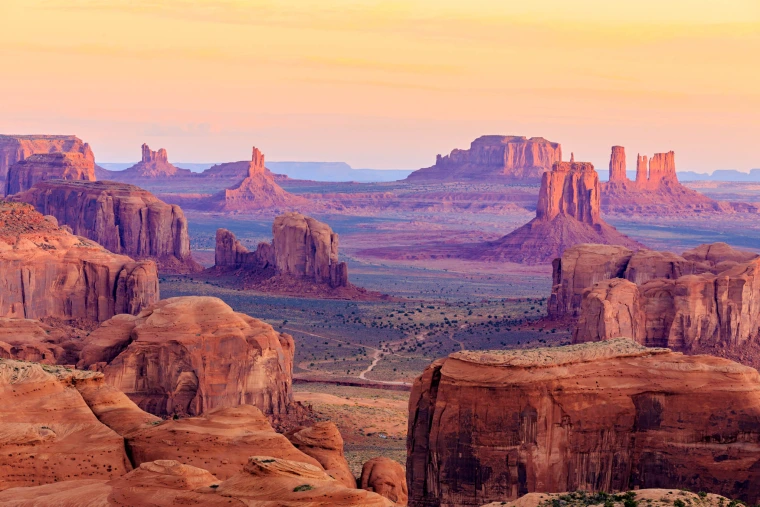
Monument Valley, Arizona
Adobe Stock
More than half of Arizona is experiencing severe to exceptional drought conditions. Meanwhile, the state ranks among the highest in agricultural water usage nationwide due to its extensive crop and food production. This situation isn’t sustainable. To produce more food using less water and meet the needs of growing populations in and outside our state, Arizona’s agriculture industry needs to reinvent itself with climate-smart, conservation-forward technologies and practices.
Guided by our land-grant mission to use our research expertise and educational resources to improve the lives of individuals, families and communities across the state, the University of Arizona is poised to meet this challenge. The U of A is shaping the future of agriculture in many ways: harnessing solar power for food production, using drones to monitor crops, working with tribal communities to integrate ancestral agricultural practices and more.
As the rapidly drying climate continues to threaten food, water and agricultural systems around the globe, the agile, real-world solutions we’re developing here will serve as models for other arid regions and foster an environmentally conscious next generation of practitioners. — Elliott Cheu, associate vice president, Research Centers and Institutes
INDIGENOUS AGRICULTURE
LEARNING FROM THE LAND
Modern agriculture can benefit from Indigenous wisdom when it comes to restoring and sustaining health and well-being for people as well as for the planet. So advocates Michael Kotutwa Johnson, assistant professor at the School of Natural Resources and the Environment, observing that in industrial farming, “We force the land to adapt to us instead of adapting to the land, and the land has suffered.”
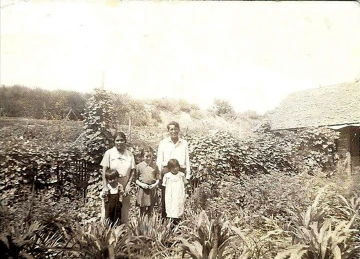
Michael Kotutwa Johnson’s grandfather, Fred Aptvi Johnson (R), and grandmother Minnie (L) with his father Caleb (L) and two aunts in Lower Moencopi on the Hopi Reservation.
Michael Kotutwa Johnson
Kotutwa Johnson leads or co-leads several studies exploring traditions, adaptations and potential new directions related to Indigenous agriculture. As a 250th-generation Hopi farmer, he knows firsthand that families and communities can successfully raise crops by working in harmony with available resources and the environment.
Through his affiliation with the university’s Indigenous Resilience Center, Kotutwa Johnson is leading the IndigeSEEDS research initiative, cultivating seeds from maize, gourds, squash and a variety of other traditional Indigenous crops in three locations: a U of A property in central Tucson, the community of Arcosanti in Yavapai County and his family’s land on the Hopi Reservation.
The project will help farmers, scientists and tribal leaders understand how the locations’ varying soils, elevations and temperatures affect the concentration of essential nutrients relative to calorie content of each crop. The study aims to provide data that can help Indigenous communities decide which crops to grow for specific environments and resources. The research could also help optimize agriculture decisions in arid and semiarid regions around the world.
__
Michael Kotutwa Johnson’s work is funded in part through the Arizona Partnership for Climate-Smart Food Crops grant ($4.7M, USDA) and the Climate Resilience through Indigenous Co-Design at the Food, Energy and Water Nexus grant ($2M, Waverley Street Foundation).
AGRIVOLTAICS AND CLIMATE-SMART CROPS
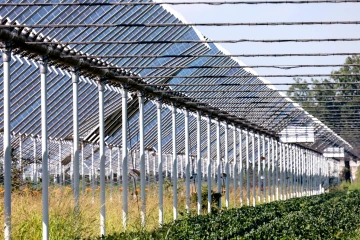
Adobe Stock
NEW TAKES ON OLD STRATEGIES
Arizona has one of the highest rates of agricultural water use per acre. Roughly 90% of that comes from groundwater, and the energy required for pumping it produces significant greenhouse gas emissions. U of A researchers are finding ways to reduce those impacts, including through agrivoltaics, or the use of solar panels to provide shade to crops.
PARTNERING WITH TRIBAL NATIONS

N. Levi Esquerra
Ryan Hunt
AN INTERVIEW WITH N. LEVI ESQUERRA
N. Levi Esquerra, U of A senior vice president of Native American advancement and tribal engagement, offers his perspective on the U of A’s commitment to expanding partnerships with tribal farmers and agriculture.
ON THE IMPORTANCE OF PARTNERING WITH TRIBAL NATIONS
“On the one hand, it’s just a natural fit, right? We’re talking about generations and generations of knowledge — there’s a steep learning curve that has already happened. And then there’s the fact that nearly 30% of land in Arizona is federal trust land for tribes. When I walk into my office, I see 22 tribal flags reminding me that there are 22 sovereign nations we serve. Many of those are senior water rights holders who absolutely play an essential role in Arizona’s future.”
ON TRIBAL NATIONS IN THE FUTURE OF ARIZONA’S AGRICULTURE
“As cities continue to push more and more farming away, I do think we’re going to see tribes playing a more prominent role in the state’s agriculture. The other thing that fascinates me is how tribal nations are blending traditional and modern methods to be as water-efficient and water-effective as possible. The Gila River Indian Community is installing solar panels over canals to reduce evaporation and cool the panels. The Colorado River Indian Tribes are now growing alfalfa, which is traditionally done with flood irrigation, using drip systems with great results.”

The Supersition Mountains, east of Phoenix
Adobe Stock
ON BUILDING EQUITABLE RELATIONSHIPS
“The first time we met with Robert Miguel, chairman of the Ak-Chin Indian Community, our only talking points were to listen and learn. When we wrapped up three and a half hours later, he said it had felt like a Sunday dinner in his family home, talking with friends. By listening and not just dictating solutions, we can offer things that genuinely benefit our partners, not just check our own boxes. This can’t be just the university extracting knowledge, so the most important thing is to prioritize listening and learning.”
AGRICULTURE VS. CLIMATE CHANGE
STRENGTHENING CROPS
Given the stakes and nature of his work, William Duke Pauli is exactly where he needs to be.
“I often say that Arizona has the climate of tomorrow today,” he explains, “and my research program is focused on the genetics of tolerance for abiotic stresses on plants, specifically heat and drought.”
Associate professor in the School of Plant Sciences and director of the U of A Center for Agroecosystems Research, Pauli grew up in Montana. His work in genomics began there, mapping genes to improve the state’s malting barley, harvested then at nearly a million acres a year.
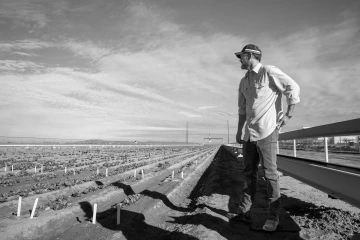
William Duke Pauli
Leslie Hawthorne Klingler
Building on that work, today Pauli is creating the most advanced agricultural research platform in the world — one that rapidly accelerates research in a race against the clock of climate change.
Pauli’s work is wide-ranging. Current projects include modeling how water moves through cotton plants, finding ways to maintain yields with less irrigation and making discoveries that could rewrite a half-century’s understanding of how plants regulate their water use. He’s collaborating with plant sciences Professor Elizabeth Arnold in research on tepary beans, looking at their arid-land adaptations and how certain microbes make them more resilient. And through it all, he’s been steadily building tools to revolutionize the speed and success of plant breeding programs.
Therein lies the throughline of Pauli’s work: discovering how plant genes drive certain physical variations — ranging from the orientation of their leaves to the depth of their roots and how much water they need. It relies on high-throughput phenotyping (HTP), a general term for technologies that quickly measure multiple physical traits in a large set of plants, like an entire crop. At the U of A’s Maricopa Agricultural Center, it’s done with sensor-equipped drones and the robotic Maricopa Field Scanner — at 75 feet tall and weighing 30 tons, the world’s largest — repeatedly passing over two acres of fields.
"My research program is focused on the genetics of tolerance for abiotic stresses on plants, specifically heat and drought.”
The datasets collected through HTP are both massive — the system generates more than 300 terabytes of data in one season — and complex. Analysis requires advanced algorithms, machine learning and AI, all working together to identify genes linked to desirable characteristics like drought resistance — traits that will be critical to food security in a hotter, drier future. That work happens on CyVerse, an open-science platform launched by the National Science Foundation and managed by the U of A, used by more than 100,000 scientists around the world.
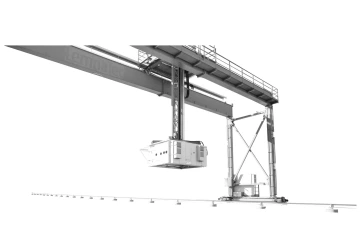
The Maricopa Field Scanner
RII
But Pauli didn’t stop with charts and words. He and his team built a system that turns all those measurements and high-resolution images into a crop’s digital twin, replicated plant by plant in every stage of growth, each replica keyed to its associated data, including genomics. Newly integrated large language models (LLMs, like ChatGPT) allow scientists to perform real-time, voice-driven analytics through the system without writing even one line of code.
All these elements converge in a critical advantage: Crop improvement studies can now be done in a fraction of the time compared to traditional methods. “Phenotyping is one of the greatest limiting factors on the rate of crop improvement,” Pauli says — a factor overcome by sophisticated modeling. And that matters, he notes. With climate change outpacing every prediction, we’re running out of time to figure out food security as the world heats up.
“For everyone working in this field, there’s so much we’ve always thought about, like ‘If I could just do that, or just do this.’ Now, here, those barriers are coming down. We have the right people. We have the Field Scanner. We have CyVerse. We have all the resources we need, and we’re in the right environment at the right time. So now it’s like, ‘Yeah, let’s do this.’”
